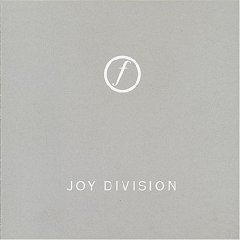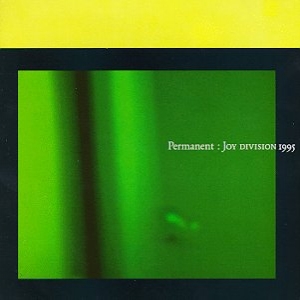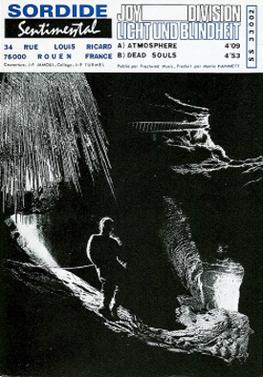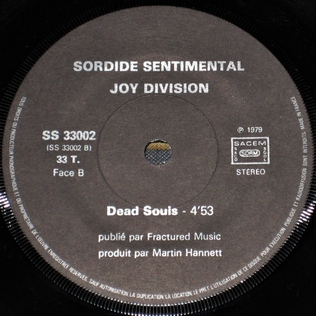
Joy Division were an English rock band formed in Salford in 1976. The group consisted of vocalist, guitarist and lyricist Ian Curtis, guitarist/keyboardist Bernard Sumner, bassist Peter Hook and drummer Stephen Morris.

New Order are an English rock band formed in 1980 by vocalist and guitarist Bernard Sumner, bassist Peter Hook and drummer Stephen Morris. The members regrouped after the disbandment of their previous band Joy Division due to the suicide of lead singer Ian Curtis. They were joined by Gillian Gilbert on keyboards later that year. New Order's integration of post-punk with electronic and dance music made them one of the most acclaimed and influential bands of the 1980s. They were the flagship band for Manchester-based independent record label Factory Records and its nightclub The Haçienda, and they worked in long-term collaboration with graphic designer Peter Saville.

Ian Kevin Curtis was an English singer, songwriter and musician. He was best known as the lead singer, lyricist and occasional guitarist of the post-punk band Joy Division, with whom he released the albums Unknown Pleasures (1979) and Closer (1980). He was noted for his unique dancing style influenced by his experiences with epilepsy, as well as his dark baritone voice. Retrospectively viewed as "one of the finest songwriters of a generation," his intensely introspective and dark lyricism has provoked "visceral and raw emotions" among fans. He was also noted for his distinct on-stage behavior, such as removing wooden tiles off the stage and throwing them into the audience and rolling around in the broken pieces of a pint pot.

Peter Hook is an English musician, best known as the bassist and co-founder of the rock bands Joy Division and New Order. Hook often used the bass as a lead instrument, playing melodies on the high strings with a signature heavy chorus effect. In New Order, he would do this, leaving the actual basslines to keyboards or sequencers.

Bernard Sumner is an English musician and record producer. He is a founding member of the bands Joy Division, New Order, Electronic and Bad Lieutenant. Sumner was an early force in several areas, including the post-punk, synthpop, and techno music scenes, as well as their various related genres, and was an early influence on the Manchester music scene that presaged the "Madchester" movement of the late 1980s centred on Factory Records and The Haçienda club in Manchester.

Unknown Pleasures is the debut studio album by the English rock band Joy Division, released on 15 June 1979 by Factory Records. The album was recorded and mixed over three successive weekends at Stockport's Strawberry Studios in April 1979, with producer Martin Hannett contributing a number of unconventional recording techniques to the group's sound. The cover artwork was designed by artist Peter Saville, using a data plot of signals from a radio pulsar. It is the only Joy Division album released during lead singer Ian Curtis's lifetime.

"Ceremony" is a song written by Joy Division, and first released as New Order's debut single in 1981. The track and its B-side, "In a Lonely Place", were recorded as Joy Division prior to the death of Ian Curtis. Both were re-recorded and carried over to Joy Division's re-formation as New Order.

Movement is the debut studio album by English pop group New Order, released on 13 November 1981 by Factory Records. Recorded in the wake of Joy Division frontman Ian Curtis' suicide the previous year, the album is a continuation of the dark post-punk sound of Joy Division's material, increasing the use of synthesizers while still being predominantly rooted in rock. At the time of its release, the album was not particularly well received by critics or audiences, only peaking at number thirty on the UK Albums Chart; the band would gradually shift to a more electronic sound over the course of the next year.

Still is a compilation album by English rock band Joy Division, consisting of previously released and unreleased studio material and a live recording of Joy Division's last concert, performed at Birmingham University. It was released on 8 October 1981 by Factory Records.

"Love Will Tear Us Apart" is a song by English rock band Joy Division, released in June 1980 as a non-album single. Its lyrics were inspired by lead singer Ian Curtis's marital problems and struggles with epilepsy. The single was released the month after his suicide.
"Isolation" is a song by English rock band Joy Division. It appears on their second and final studio album Closer (1980). The song is based on an electronic drum beat by Stephen Morris, accompanied by a thin, trebly keyboard part by Bernard Sumner. Midway through the song, a rushing drum and hi-hat motif come in, propelling the song toward its dramatic end.

Permanent is a compilation album by English post-punk band Joy Division. It was released in the United Kingdom on 8 May 1995 by London Records and in the United States on 15 August 1995 by Qwest Records and Warner Bros. Records. The album charted for three weeks and peaked at number 16 on the UK Albums Chart.

"Atmosphere" is a song by the English post-punk band Joy Division. It was originally released in March 1980 by the Sordide Sentimental label as the "Licht und Blindheit" package, a France-only limited edition single featuring the track "Dead Souls" as the B-side. Following Ian Curtis's death in May, it was re-released as a 12" single by Factory Records in August with "She's Lost Control" as the B-side.
"New Dawn Fades" is a song by English rock band Joy Division from their 1979 debut album Unknown Pleasures. The song opens with a backwards and heavily modified sample from a previous song, "Insight", presumably added by Martin Hannett, post-production.
The discography of English rock band Joy Division consists of two studio albums, four live albums, twelve compilation albums, three extended plays, and five singles. The list does not include material performed by former members of Joy Division that was recorded as New Order or related side projects.

Peter Hook and The Light are an English rock band, formed in May 2010 by bassist and vocalist Peter Hook, formerly of the influential post-punk bands Joy Division and New Order. The band also features Hook's son Jack Bates (bass), as well as Andy Poole (keyboards) and Paul Kehoe (drums), who both played with Hook as part of Monaco, one of Hook's previous groups. From the first gigs in May 2010, Nat Wason was the group's guitarist, however in July 2013 he was replaced by David Potts, another former member of Monaco.
"Atrocity Exhibition" is a song by the English post-punk band Joy Division. It is the opening track on their second and final album Closer. The song was produced by Martin Hannett and Joy Division. It was recorded at Pink Floyd's Britannia Row Studios in London.
"Disorder" is a song by English rock band Joy Division, released as the opening track of their 1980 debut album Unknown Pleasures. It was co-written by band members Ian Curtis, Peter Hook, Bernard Sumner and Stephen Morris (drums). The music for the track emerged through their usual method of jamming through long practice sessions, and had been played live a number of times before its studio recording. It was produced and engineered by Martin Hannett, who was also a partner at the band's label Factory Records.

"Dead Souls" is an 1980 B-side by the English post-punk band Joy Division. Co-written by band members Ian Curtis, Peter Hook, Bernard Sumner and Stephen Morris (drums). Centered on a circular bass line by Hook that had a significant influence on 1980s Gothic rock, the song was named by Curtis after Nikolai Gogol's 1842 novel Dead Souls. The song contains a lengthy intro designed as the opening for live gigs. The track was recorded in late 1979 during the same sessions as "Transmission" and "Atmosphere".















